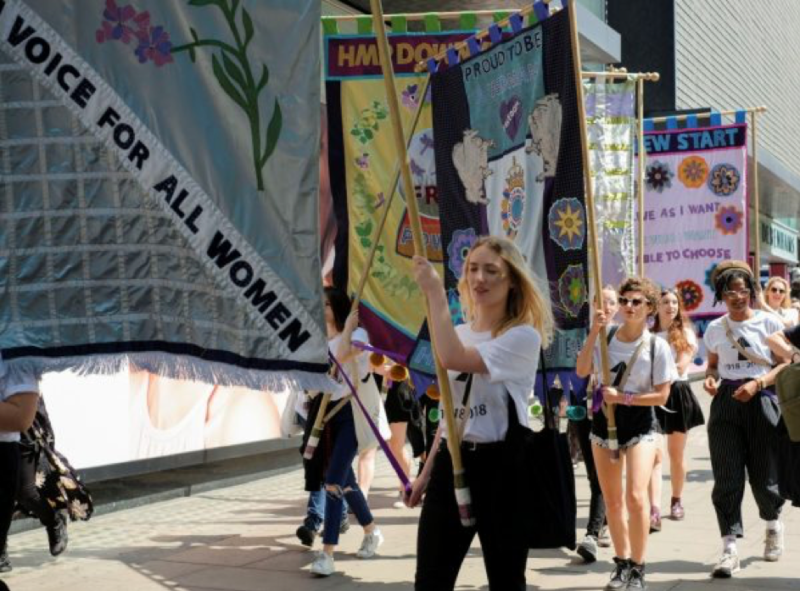Outstanding!
To encounter the performance Procession Banners (2018)[1] by Lucy Orta is to face the “sovereign image”.[2]
This work leads the viewer beyond the sense of the conventional, as it draws attention to the written words. We can use Lacan’s registers – the symbolic, imaginary and real – to aid our understanding of this work of art.
Presentation
Lucy Orta is an English visual artist, born in 1966, who graduated in fashion design. She investigates boundaries between communication and identity.
Orta’s art has been the focus of major exhibitions.
Encountering the real
To mark International Women’s Day, Lucy Orta has been working with prison inmates to produce procession banners to echo the suffragette demonstrations of a century ago in the UK.
But as soon the viewer’s attention turns to the words written on the banners, one may start to feel uneasy (unheimlich).
The speakable
Lucy Orta says: “we are finding ways to draw the public’s attention on very difficult subjects, strong issues, political and social crises. Telling a story tries to keep politics utilitarian matter and at the same time, something which is not functional. Our work is not didactic but esthetic.”
Here the sayable has an advantage over the visible. The performance Procession Banners is veil-less. As such, it claims to be the very Thing (das Ding). By the action of the artist, the written words lead the viewer to an iconic image.
Spanning a gap, the sovereign image convenes an array of words, a frame and a slot. Following Jacques-Alain Miller[3] – these visual operators grant it a unique value such as a signifier. Moreover this image (image Une) refers to the significantised element.

The invisible signifier
The viewer is a mere spectator who is capable of looking and being looked at, of reading but what it is there to read?
From a Lacanian standpoint,[4] the subject is subordinated to language. To illustrate the interval between speech and the letter, the written words as an iconic image bring into play one’s interpretation.[5]
The banners display the following slogans: “be wise, strong, powerful, a voice for all women”, which all point out a key tension in the master discourse for silencing the object a, here: women.[6]
Lucy Orta’s art operates by treating the real with the symbolic. This work of art provides a new modality of the visible.
[1] Lucy Orta, Ikon Gallery, Birmingham, UK.
[2] Jacques-Alain Miller, “The Sovereign Image”, The Lacanian Review, Hurly-Burly, No. 5, 2018, p. 39
[3] Ibid.
[4] Jacques-Alain Miller, Aphorisms and Questions on Meaning and the Real, p. 61, In The Review Hurly-Burly, issue 7, May 2012 published for the Freudian Field, by the New Lacanian School
[5] Lacan Jacques « Radiophonie » in Autres Ecrits, Seuil, Paris, 2001, p. 428
[6] Brousse Marie Hélène, http://www.radiolacan.com/fr/topic/1157/3, Conférence « Domination! Que se passe-t-il aujourd’hui entre les hommes et les femmes? ».
Images:
Photo: Michelle Marshall. Courtesy: Lucy + Jorge Orta
2018 Ikon Gallery Birmingham, UK; Processions Women’s March, London. Courtesy: Lucy + Jorge Orta, commissioned by Historic England

